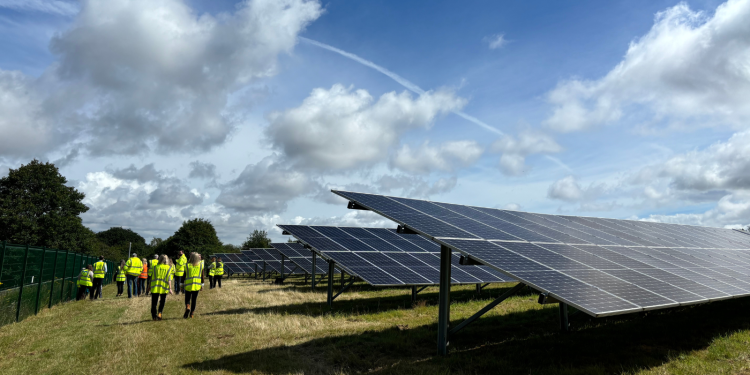Kent solar park enhances old landfill site

£4.1million project produces clean energy for the community while enhancing wildlife.
It was smiles all round at Kings Hill Solar Park in West Malling when it was officially opened earlier this week.
The site, located near the Kent Scientific Services building on Abbey Wood Road, is now home to 6,480 solar panels thanks to funding delivered through Phase 1 of the Public Sector Decarbonisation Scheme.
Our team was thrilled to attend a special opening ceremony and tour the area to learn more about how the project is making a positive difference to people and the planet.
At the event on Tuesday, Councillor Robert Thomas, cabinet member for environment at Kent County Council, said: “As the relatively new cabinet member for environment, it’s really pleasing to see that this project has come to fruition.
“We understand that the residents of Kent absolutely want this infrastructure in place, we understand the challenges of energy security in recent times, and this will certainly play its part.”
We understand that the residents of Kent absolutely want this infrastructure in place, we understand the challenges of energy security in recent times, and this will certainly play its part.
The panels are connected to the county’s main grid and are expected to generate enough clean, green energy to power 750 local homes throughout the year.
The project also anticipates that more than 630 tonnes of carbon emissions will be offset, supporting the council’s aim to reach carbon neutrality by 2030.
Councillor Thomas added: “Another fascinating part of this project is the council’s net zero commitments and through this project, 633 tonnes of carbon will be offset, so we’re going some way to offset our own estate and that of the wider county.”
As well as creating energy, local wildlife is set to benefit. The site promises to improve the biodiversity of the area thanks to a dedicated growth zone for wildflowers and accompanying wildlife protection spaces inclusive of a new reptile receptor area, bird and bat boxes and a herd of sheep grazing the land where the solar has been installed.
The project has taken more than two years to complete and was funded under Phase 1 of the Public Sector Decarbonisation Scheme as part of Kent’s successful bid for £20,643,014. Funding for the scheme is delivered by Salix on behalf of the Department for Energy Security and Net Zero.
The council plans to use lessons learned for future opportunities for similar schemes, having overcome some challenging circumstances to achieve success. Challenges included biodiversity improvement requirements, DNO connection delays and access issues to name a few.
The solar park is one of several renewable energy sites being built across the county. Other sites include the UK's biggest solar park of 900 acres in Graveney, between Faversham and Whitstable.
This ‘decarbonisation’ project supports the county council’s net zero action plan with services contributing to both a corporate target of net zero greenhouse gas emissions by 2030 and the Kent-wide net zero target by 2050.
Rebecca McNamara, programme manager at Salix, said: “Tuesday was a positive opportunity to see the results of the incredible work progressed at the site – turning an old landfill site and pig farm into an area that will benefit Kent by generating clean energy for the community, as well as supporting the local wildlife.”
Whilst local people may be benefiting immediately from the work, the local wildlife will take longer to adjust. Biodiversity studies aim to regenerate the area for wildlife including reptiles, birds, wildflowers, sheep, shrubs, butterflies and more.
Danielle Huxter, project manager at Kent County Council, said: “It’s a very low-maintenance area, pretty much left for the wildlife to kind of take it back and do what wildlife does.”
The council has scheduled regular biodiversity inspections to track how things are progressing, with the first inspection earlier in July showing early positive signs that biodiversity enhancement measures are working.
It’s a very low-maintenance area, pretty much left for the wildlife to kind of take it back and do what wildlife does.




